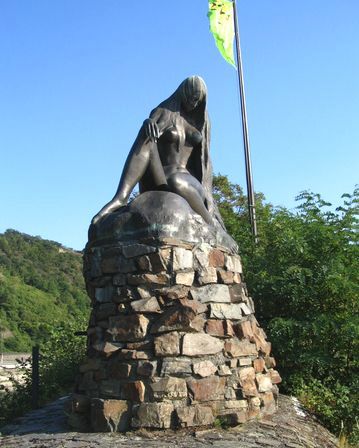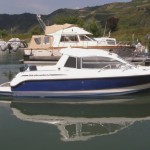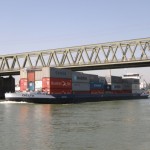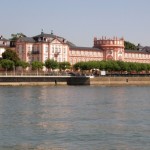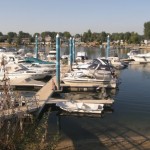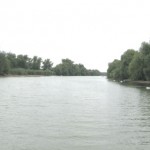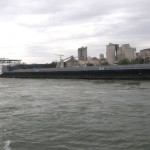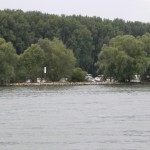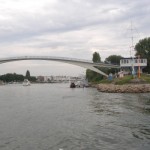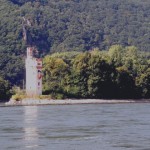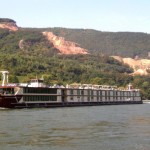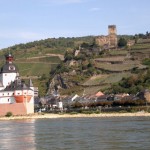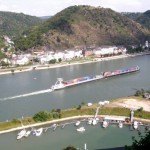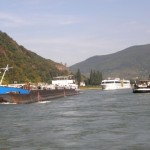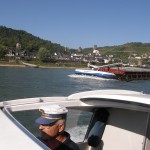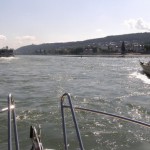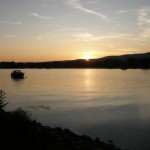Germany 2009 II
The beautiful and adrenaline-pumping Rhine
The Rhine, an European major river, is a busy waterway with never ending flow of cargo and passenger boats and with ferry boats substituting bridges, carved into a deep valley in the middle reaches with frequent traces of ancient history and with vineyards hanging on the steep slopes. This is a river section offering lot of excitement, sometimes even adrenaline-pumping experience for “little bargees”. And also, is there anybody not wanting to greet from the river surface the beautiful Loreley that “seduced” the Rhine bargees many centuries ago?
Stage 1: New river, new boat
We start from the Heidenfahrt marina approximately at 11.00 am. The marina is on the Rhine’s side branch, kilometre 513. For today, we have planned sailing up the river “as far as we like”. After several moments when I become acquainted with the boat, we navigate to the main river stream and we get into the centre of action. The stream speed is about 5 km/hour, the river is up to 500 meters wide and there is really unusually busy traffic there. The counter-flow or manoeuvring among other boats is no problem for our boat. And why should? Name: “Neptun”, length 7.3 m, engine MerCruiser 2.8 litres with the output of 110 kW, maximum cruising speed is 55 km/hour. The only weak point during the navigation could perhaps be the “captain’s inattention”.
After half an hour we sail past the capitals of two German federal republics: Wiesbaden on the right bank and Mainz on the left bank. The voyage continues along the river adapted for boat traffic only by regulation and in open landscape. The weather at the end of August is almost tropical and therefore it would be advisable to finish the day with taking some bathe, so that we have to do the following: to stay overnight in Luy marina at the Eicher See, which is the former “bagersee” connected with the river at the river kilometre 466. The marina is really nice and perfectly equipped with all we need; each boat can even use a TV connection. So we spend the remaining time of the day bathing. And the today’s “bill”? It is 47 river kilometres upstream.
Stage 2: Examining where to anchor
Today we do not want just to navigate down the river back to Heidenfahrt. We want to “examine” the chances for anchoring in this river section. Since the very beginning of our voyage we pass by large number of cargo boats. The boats are mostly the standard large Rhine motor boats with the dimensions of 110 x 11.4 m with the carrying capacity of 2.700 tons of cargo. However there are still many surviving older and smaller “lorries” and we also met trip boats.
And how did our examination turn out? At the river kilometre 474 we turned off to Elferder Altrhein, a cut-off meander of the former river bed, which led to a nice YC Darmstadt marina after covering the distance 8 km. We navigated there and back through a wildlife sanctuary with a lot of herons, gulls or cormorants… There was an opportunity to anchor and to buy fuel in Hafen Oppenheim at the river kilometre 480. An imposing change was made at the river kilometre 506: “Schiersteiner Hafen” at the Wiesbaden suburbs has been recently changed into a swimming pool with several luxurious marinas. And one more observation: at the river kilometre 497, Main is flowing into the Rhine. This junction of rivers “disappointed” me quite a lot with small width of the mouth. When I realise that this is the place where the very important and busy waterway of Main – Donau begins …
Today we have “covered” about 63 river kilometres including detours. The weather is still very hot.
Stage 3: Let’s go down
We are looking forward to today’s day. I have the boat already “under my command” and the “feared” Gebirgsstrecke with the Binger Loch gorge is ahead of us. We are going to sail downstream and we plan to get to St. Goar at the river kilometre 556. So “let’s go down”.
During the several first kilometres, the river is still “normal”. But it begins to carve gradually into the landscape, both banks rise up with steep slopes covered with picturesque vineyards. At the river kilometre 527, a turnover comes: the river starts to “flow downhill” and the stream is getting stronger, accelerating up to 10 km/hour. Bingen city famed for the “Mäuseturm” on the small Rhine island indicates the beginning of the Binger Loch. This ravine was always a challenge and fear for many Rhine bargees. The sailing corridor is narrow and is hard to navigate for both downstream and upstream boats especially when the traffic here is like on a highway. Many cargo ships achieve the speed over 25 km/hour here when sailing down the river. With some hyperbole we may say that the “bargee’s final examination” could and should be passed here.
The strong stream continues also during the following kilometres, however the sailing corridor is well-marked with buoys and shows a safe way among many shallow spots and rocks. At last I have more time to watch the river surroundings: the reputation of the “valley of castles and vineyards” did not disappoint me. At least two castles or castle ruins are visible at any moment. And the experience culminates with the famed Loreley, a rock promontory towering 130 m above the water level.
We anchor overnight in St. Goar harbour after we covered about 43 km. The marina is “pleasant” in particular thanks to its position under the Rheinfels castle towering above our heads and thanks to the view of the Katz castle on the other bank of the river. We refuelled there in the morning, even though we had to use fuel cans and two-wheeled cart to get the petrol from the petrol station being 200 m away.
Stage 4: Upstream adrenaline
We are setting out back to Heidenfahrt after 10.00 am. I have read somewhere that “… it is not advisable to recommend the weekend captains trying to navigate through (this section) in the upstream direction…” I do not know if due to their limited sailing experience, difficult terrain or quality of their boats. However I can rely on the power of our “Neptun” …
Nevertheless it is clear from the beginning that this will not be “a piece of cake”. Ahead of us, about ten cargo boats and hotel “high-rise” boats are scrambling upstream “in first and at full throttle” and the same string of boats is speeding downstream. The stream of 10 km/hour causes significant troubles to them and the speed of the boats sailing upstream is not breathtaking at all. I decide to overtake them gradually before the Binder Loch. But the strong stream, the narrow sailing corridor, the frequent river bends disallowing sufficient view ahead and the “turbulent” water make this a little adrenaline-pumping affair. To overtake a 120 m long boat in this situation requires the speed of at least 30 km/hour, which is actually 40 km/hour “up the stream”.
“Upstairs” we have a break in the Bingen harbour with a good marina, but it is quite far away from the city centre. Then we just have to sail to refuel our boat and to return to our home harbour in Heidenfahrt having covered 55 km today.
In total we sailed about 200 km along the Rhine river. It was no problem with our powerful boat. After many years of experience with navigating along canals, lakes and rivers, I would like to say: “If you never navigated the Rhine, it is like you navigated nowhere”.
August 2009
Charter: www.rmbc.de
